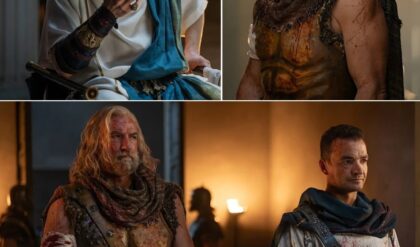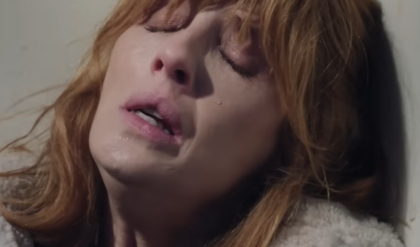Is Dark Winds Based on a True Story? The Real Inspiration Behind the Navajo Detective Thriller
:max_bytes(150000):strip_icc():focal(749x0:751x2):format(webp)/dark-winds-4-082824-f44acd8daa1849238b35eedf207d3f5d.jpg)
When AMC’s Dark Winds premiered, audiences were immediately drawn into its haunting mix of crime, mystery, and Navajo identity. With its dusty desert landscapes, noir atmosphere, and complex Native protagonists, the show struck many viewers as uncomfortably real — prompting the inevitable question: is Dark Winds based on a true story?
The answer is both yes and no.
While the series is not a direct retelling of historical events, it is adapted from Tony Hillerman’s long-running series of crime novels featuring Navajo Tribal Police officers Joe Leaphorn and Jim Chee. The books, written between 1970 and 2006, blend murder mysteries with the cultural, spiritual, and social backdrop of the American Southwest. Hillerman’s stories are fictional, but they are deeply rooted in the realities and history of Native American communities, particularly the Diné, or Navajo Nation.
Fiction Grounded in Real History
Unlike purely fantastical crime dramas, Dark Winds integrates very real historical themes into its fictional storylines. In its first season, the show touches on two particularly painful chapters of 20th-century Indigenous history.
The first is the forced sterilization of Native American women, a widespread practice throughout the 1960s and 1970s in which thousands of women were sterilized without full knowledge or consent. For Indigenous communities, this amounted to a devastating violation of human rights and an attempt to control population growth in marginalized groups. By weaving this issue into its narrative, Dark Winds ensures that viewers confront a history many Americans remain unaware of.
The second theme explored is that of government-run assimilation boarding schools, where Native children were forcibly removed from their families, punished for speaking their languages, and pressured to abandon their cultures. These institutions — operating well into the late 20th century — left scars on generations of Indigenous families. In Dark Winds, the trauma of these schools surfaces in the characters’ backstories and motivations, adding depth and authenticity to the fictional crime plots.
:max_bytes(150000):strip_icc():focal(749x0:751x2):format(webp)/dark-winds-6-082824-2cc3045903da4ae9896c5baef0b4edc0.jpg)
Adapting Hillerman Through a New Lens
The novels behind Dark Winds were written by Tony Hillerman, a White author who spent decades in the American Southwest and developed a fascination with Navajo culture. While his books were widely acclaimed — winning awards for their sensitive portrayal of Native traditions — his outsider perspective was not without controversy.
For the television adaptation, showrunner Graham Roland and his producing team, which includes George R.R. Martin and Robert Redford, set out to bring greater authenticity to the material. That meant hiring an all-Native American writers’ room, led by creators such as Billy Luther, who explained the mission: “Our job was to take Hillerman’s books and make them more authentic.”
Roland himself has emphasized that, while Dark Winds is fictional, its cultural grounding needed to feel real. “It’s about creating a world that honors the Diné people,” he said.
A Course Correction
Despite these intentions, Dark Winds faced criticism after its first season for blending Indigenous traditions in ways that were inaccurate or misleading. Some Navajo viewers noted that specific customs were portrayed incorrectly, or that the show conflated practices from different tribes, creating a generalized “Indigenous” identity rather than a strictly Navajo one.
Director Chris Eyre, himself a member of the Cheyenne and Arapaho Tribes, acknowledged the criticisms and described them as opportunities for growth. He told the Navajo Times that the production team made deliberate “course corrections” after hearing these concerns. Among the changes were the hiring of a cultural advisor and a Navajo language consultant, ensuring that future seasons would better reflect the community’s lived experiences.
Characters as Cultural Ambassadors
For many fans, one of the most compelling elements of Dark Winds is its lead characters: Joe Leaphorn, played by Zahn McClarnon, and Jim Chee, played by Kiowa Gordon. Both are Navajo officers tasked with solving crimes that often intersect with the struggles of their community.
:max_bytes(150000):strip_icc():focal(731x330:733x332):format(webp)/dark-winds-2-082824-49e43ffb0a47492989474cf3ab27eff3.jpg)
Through them, viewers are introduced to the complexities of modern Navajo life — the push and pull between traditional culture and external pressures, the legacy of historical trauma, and the resilience of a people who continue to thrive despite generations of systemic hardship. McClarnon, who also serves as an executive producer, has been praised for bringing nuance and depth to Leaphorn, ensuring he is more than just a detective archetype.
The Line Between Fiction and Truth
So, is Dark Winds a true story? Strictly speaking, no. The murders, conspiracies, and noir twists at the heart of the plot are fictional creations. But the world in which those crimes unfold is steeped in truth — from the landscapes of the Navajo Nation to the cultural references and historical traumas that shape the characters’ lives.
The blend of fiction and reality is intentional. By framing real struggles within a gripping crime thriller, the show introduces a wide audience to Indigenous histories that have too often been erased from mainstream narratives.
Conclusion
Dark Winds may not be a true story, but its inspiration lies firmly in real history and lived experience. By adapting Tony Hillerman’s novels through the lens of Native creators and consultants, the series walks a fine line between entertainment and education.
For audiences, it offers more than just a murder mystery — it provides a window into the resilience of the Navajo people, the injustices they endured, and the cultures that continue to endure against the odds. In that sense, while the crimes may be fictional, the truths revealed are very real.





